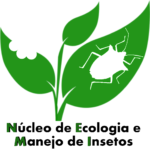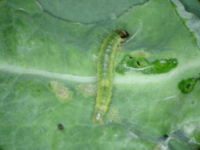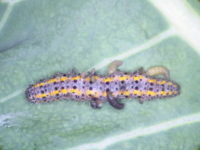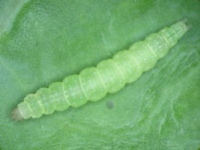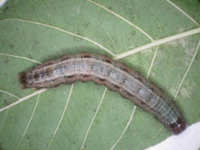Main projects
Currently, NEMI is developing the following projects:
1. Development of a phenological model for the wheat armyworm, Mythmina sequax.

Temperature is considered one of the most important abiotic factors influencing the development, survival, reproduction, and, consequently, the population dynamics of insects. Studies that evaluate the effects of temperature on insect biology are essential for the development of phenological models used to predict the occurrence of insect pests. This project aims to develop and validate phenological models for predicting the development time of the wheat armyworm in the field. This study will contribute to the development of management strategies for this important species providing a tool for decision-making regarding the appropriate moment for the adoption of control measures.
2. Development of a phenological model for the tomato leaf miner, Tuta absoluta.

This project aims to select development rate models for the tomato leaf miner, Tuta absoluta. Recently, T. absoluta invaded the European continent and in the subsequent years spread to North Africa and West Asia. This species has caused severe damage in the regions where it was introduced, leading to a significant increase in the number of insecticide applications. The use of phenological models to predict the occurrence of T. absoluta can be an alternative to the reduction in the use of pesticides.
3. Global potential distribution of Bactrocera carambolae and evaluation of the risks for fruit production in Brazil.

The carambola fruit fly, Bactrocera carambolae, is a species native to Asia that has invaded the South American continent through the small-scale trade of fruits from Indonesia. The economic damages caused by other species of fruit flies introduced in the continent and the polyphagous behavior of B. carambolae have prompted much concern among government agencies and farmers with the potential spread of this species. In this context, this project aims to use ecological niche models to determine the suitable areas for the occurrence of B. carambolae on a global scale, as well as to evaluate the area of fruit production under risk of attack in Brazil.
4. Spatial distribution and the factors related to accidents caused by spiders in Santa Catarina, Southern Brazil.
 Several spiders are synanthropic and often interact with humans causing envenomation. Although several studies have evaluated the epidemiology of spider accidents in recent years, comparatively few studies have investigated the existence of patterns in the distribution of spider bites. This project aims to evaluate the epidemiology and seasonality of accidents caused by spiders in Santa Catarina, Brazil, as well as to understand the factors related to the distribution patterns observed in these accidents.
Several spiders are synanthropic and often interact with humans causing envenomation. Although several studies have evaluated the epidemiology of spider accidents in recent years, comparatively few studies have investigated the existence of patterns in the distribution of spider bites. This project aims to evaluate the epidemiology and seasonality of accidents caused by spiders in Santa Catarina, Brazil, as well as to understand the factors related to the distribution patterns observed in these accidents.
5. Climate change impacts on the distribution of native bees.
 Historically, it has been recognized that human actions on the environment can generate a severe modification of ecosystems. The increase in the levels of greenhouse gases in the atmosphere is an emblematic example of environmental change directly related to anthropic actions. This situation has caused an increase in the global temperature and changes in precipitation regimes in different regions of the world, affecting drastically the climate of the planet. Due to the close relationship between species distribution and climate, current and expected future climate changes may result in changes in the pattern of species distribution. This project proposes to use ecological niche models to understand how climatic change can affect the distribution of Brazilian stingless bees of the genus Melipona. The information generated by this study can be used for conservation purposes, considering the important ecosystem services provided by these species.
Historically, it has been recognized that human actions on the environment can generate a severe modification of ecosystems. The increase in the levels of greenhouse gases in the atmosphere is an emblematic example of environmental change directly related to anthropic actions. This situation has caused an increase in the global temperature and changes in precipitation regimes in different regions of the world, affecting drastically the climate of the planet. Due to the close relationship between species distribution and climate, current and expected future climate changes may result in changes in the pattern of species distribution. This project proposes to use ecological niche models to understand how climatic change can affect the distribution of Brazilian stingless bees of the genus Melipona. The information generated by this study can be used for conservation purposes, considering the important ecosystem services provided by these species.

